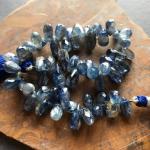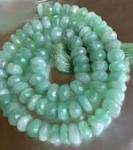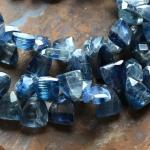

Kyanite is most often a brilliant blue gemstone. The word "kyanite" comes from the Greek, kuanos, meaning deep blue.The quality of kyanite that is acceptable for gemstones is rare, with the most common uses of this mineral in industrial products: ceramic products, from dishes to porcelain plumbing fixtures, (think sinks, tubs, etc.), abrasives, electrical insulators, and other items. It is difficult to use kyanite as a gemstone on account of its tendency to be splintery. It just isn't easy to cut! It is also of only moderate hardness, registering a 4.5-5 on the Mohs scale.* This accounts greatly for the costliness of the stones. But when it does cut well, when it shows off that fabulous, intense blue striped with white, how amazing!
Not all kyanite is blue, by any means. Green, pink, orange, gray, yellow and even black do crop up from time to time, but are even more rare than the blue, and on the occasions that they are used as gemstones, naturally more pricey.
Kyanite is counted among the pleochroic, or "color change" gems, going from blue to pale blue to clear. The best kyanite is transparent to translucent, and on very rare occasions, it may display a "cat's eye" chatoyancy. Fine stone cutters try to bring out the color-change qualities of this fantastic gem.
Scientifically, kyanite is a member of the aluminosilicate series, which also includes the famous andalusite.
*Mohs ranges from the softness of chalk at 1 to diamond hardness which registers 10.







